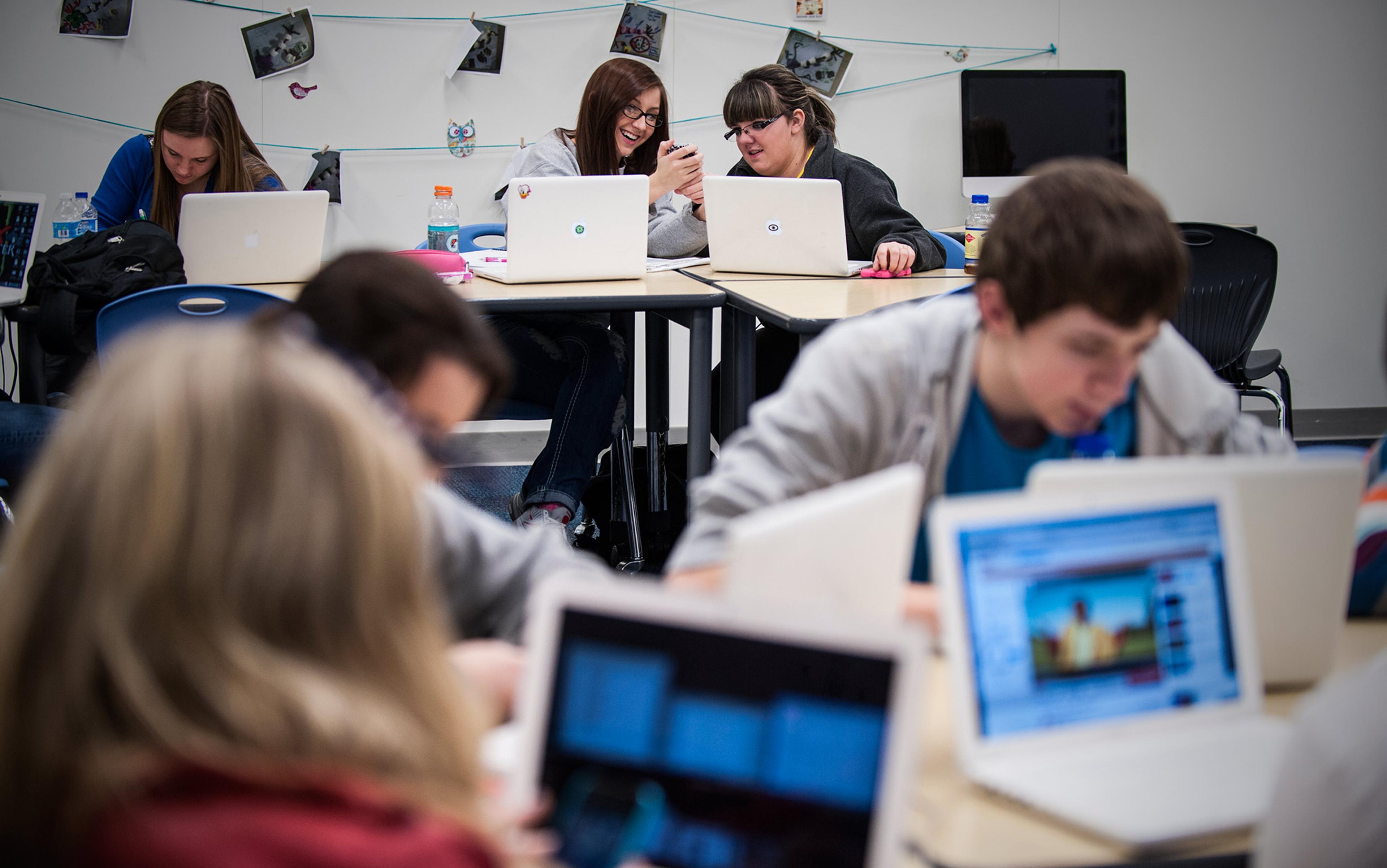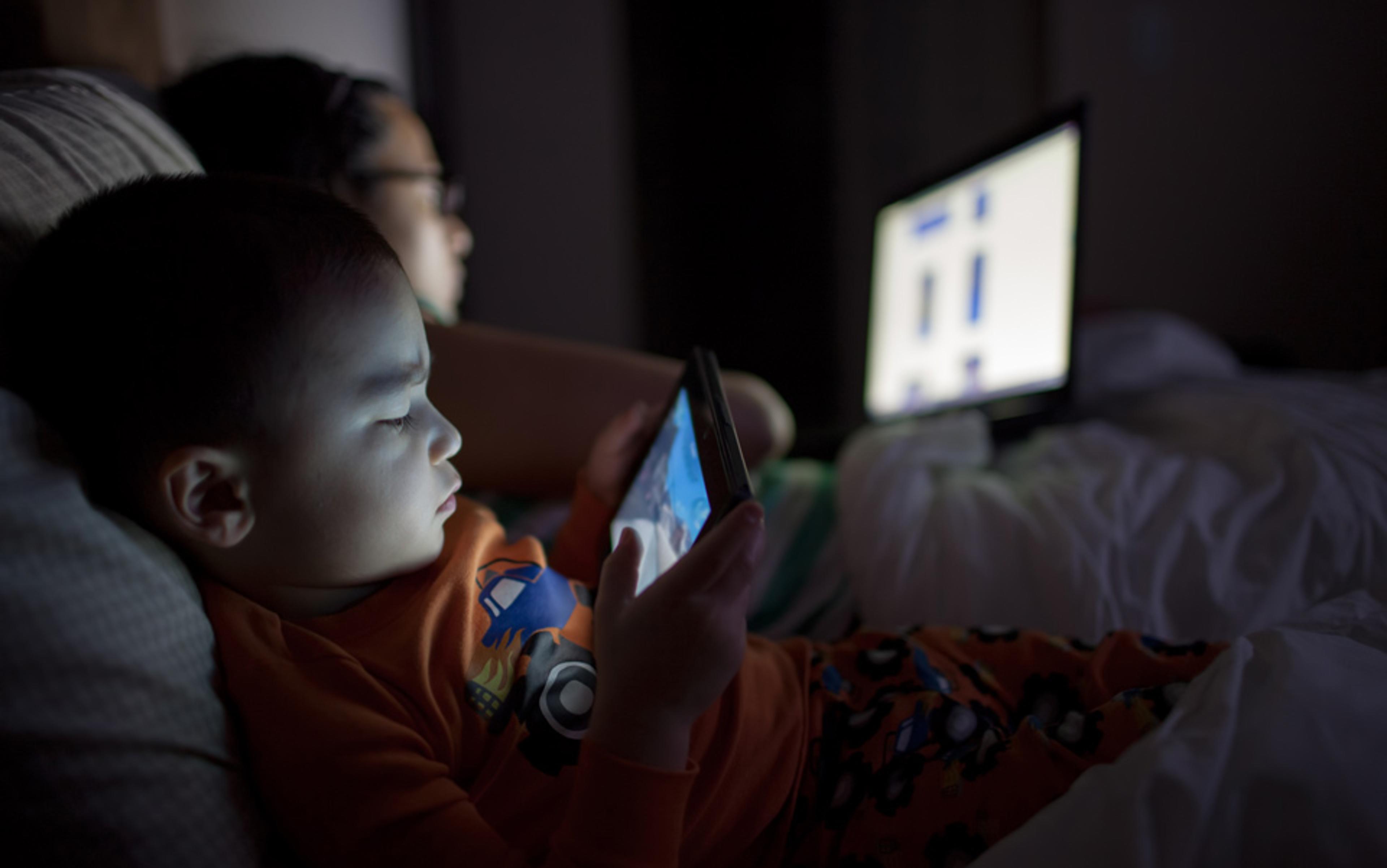I have a rule about cellphones in class: if one disrupts us by ringing, vibrating or sounding an alarm, the owner has to sing a song or bust some dance moves in front of the class. At first, this provision in the syllabus elicits snickers, but it’s no laughing matter. You need to be able to turn off your phones and pay attention, I say. On the first day of class, they shut off their phones. But it doesn’t stay that way.
While my students – undergraduates at Boston University who are taking classes on writing and research – agree that there’s a problem if they can’t go 50 minutes without checking their phones, few of them can resist, despite knowing that this is my biggest pet peeve. A University of Nebraska-Lincoln study indicates that 80 per cent of college students send text messages during class. Nearly 100 per cent of them text before and after class. In the minutes before class – the ones I used to spend shooting the breeze with students about TV shows, sports or what they did over the weekend – we now sit in technologically-induced silence. Students rarely even talk to each other anymore. Gone are the days when they gabbed about the impossible chemistry midterm they just took or the quality of the food at the dining halls. Around the 30-minute mark in class, their hands inch toward their backpacks or into their pockets, fingers feeling around for the buttons as though their mere shape offers comfort. When I end class, they whip out their phones with a collective sigh of relief, as though they’ve all just been allowed to go to the bathroom after having to hold it all day.
Even when my students stash their cellphones, my classes look like an Apple commercial – faces hide behind screens embossed with the same famous fruit. I have no delusions that they’re taking notes for class or referencing that day’s reading. A University of Waterloo professor who put a postgraduate at the back of his lecture hall to observe his students learned that 85 per cent of them did something unrelated to class on their laptops; a Cornell University study confirms that most students engage in ‘high-tech “doodling”’ and communication during class. One might think that the whopping $65,000 cost of attending Boston University for a year would provide ample reason to maintain focus during class, but one would be wrong.
Even students who take notes on their laptops miss out. A study from Princeton University shows that we process information better when taking notes by hand because writing is slower than typing (an argument often spun in favour of laptops), which helps students learn and retain the material. Similarly, people better comprehend what they’re reading if it’s on paper rather than on the screen. In a study from the University of Stavanger in Norway, readers on Kindle struggled to remember plot details in comparison with those who read printed books, perhaps because the physical act of turning the pages helps our memories encode the words. Another study revealed comprehension loss for subjects reading PDF versions of texts. Such findings have caused professors to ban computers in the classroom, which is something I used to do but can’t any more.
An increasing number of students present me with documentation from the student disabilities office that entitles them to use a laptop to take notes. If students see a few classmates with laptops, they inevitably start using theirs too. I can’t tell them that only a couple people are sanctioned to use the computers because of learning or cognitive difficulties without infringing on the students’ privacy, so I try instead to encourage students to take notes by hand and I ask to see their faces, not their Apples.
In an effort to save my students exorbitant coursepack fees, I used to photocopy course readings. But when my department clamped down on copier use, I scanned the articles and put them online, which meant I had to allow students to open their laptops during discussions. On the one hand, they’re adults – if they want to go to shop for shoes on the Zappos website or look at celebrities’ Instagram accounts during class, they’ll have to deal with the consequences. But our discussions suffer, which makes my job harder. When reading on screens, students don’t annotate or reread. They get glassy-eyed, zone out, and then struggle to find quotes they only vaguely remember when it comes time to write the paper. The endless opportunities for distraction also mean that they miss other aspects of class, including important instructions.
That’s when they come to me and we have some version of the following conversation:
Student: ‘I have no idea what’s going on.’
Me: ‘What do you mean “no idea”? The assignment sheet details all the requirements, we’ve reviewed them in class, and we’ve read example essays. What exactly are you having trouble understanding?’
Student: ‘I don’t know… everything?’
I used to jump to the conclusion that students with whom I had such interactions were inherently flawed, academic lost causes. But that’s a reductive explanation, and doesn’t get at the heart of the problem; it’s not just that they have trouble paying attention or are distracted by their phones or laptops in the classroom. The problem is their use of technology in general. Technology demands a significant amount of time and attention and has conditioned them to not question it. It takes up more and more of their bandwidth, and the net effect is lobotomising.
Consumed by technology that they cannot bear to disable or ignore, my students lose awareness of what’s going on around them. They don’t know what they’ve missed – often, they don’t know that they’ve missed anything. They’re still accountable for it, but such mindlessness has become an epidemic: a study from the Ohio State University found that walking while texting has caused a significant rise in injuries. In Chongqing in China, sidewalks contain a special lane for people who can’t be bothered to look up from their phones. And in the German city of Augsburg, there are traffic signals on the ground for people who would otherwise endanger themselves by failing to notice red lights.
Part of the reason people can’t seem to look up from their phones is that we’ve convinced ourselves we’re multitasking, rather than failing to focus (like the way I toggle between various browser tabs and apps even as I write this). A California State University study monitored middle-, high-school and college students who had been instructed to research something important for 15 minutes. Two minutes in, students’ focus started to wane as they checked messages, texts and various websites. The average student lasted six minutes before caving to the temptation to engage in social media. Despite being watched, students spent only approximately 65 per cent of the allotted time studying. Given that most students spend far longer than 15 minutes trying to do coursework, it’s easy to see how little gets done, and how checking messages or opening up another browser tab would be increasingly difficult to resist, especially if we tell ourselves it’s related to work or study.
At the end of each semester, my students submit a portfolio that chronicles their work over the past 16 weeks. I ask them to reflect on what they’ve learned, both in terms of tangible skills and about their own tendencies. Students write insightful and honest self-analyses; they confess to all kinds of bad habits they’ve developed in college or perpetuated since high school, such as procrastinating, skipping proofreading or staying up all night playing video games.
Increasingly, students express dismay at their ability to manage time and to stay focused. Though I’m grateful on a daily basis that Facebook and cellphones weren’t around when I was in college, this isn’t a new problem. Students have always found more satisfying ways to spend time than writing essays and studying for tests; even with nothing urgently (or not so urgently) fun to do, they have always waited until the last minute. But now students who aren’t necessarily procrastinators, or who used to be able to focus on assignments, find it harder and harder to fight distraction.
This semester, a student who initially impressed me as a rising star in my class wrote the following in his final portfolio:
I constantly procrastinate, leaving huge chunks of writing until the last minute, or sometimes until a few minutes past the last minute… Even now, on the last, easiest assignment, I left it until the last minute, and am still procrastinating. It’s 3 in the morning, and instead of consistently working on my portfolio, I’m watching a video review of a hammock. I’ve never even used a hammock. I have a serious problem in making myself do work, and even I’m not entirely sure why. Even when the work interests me, as [this class] does, and the work is important, I am still bizarrely capable of feeling absolutely no compulsion to work.
It is almost like the student is describing a Body Snatchers scenario, getting taken over by forces he’s aware of but can’t seem to control. What are those forces, exactly? And can he – or anyone – really control them?
Sure, students can use one of many available products to curtail their online forays and curb their appetite for distraction. But these products block websites or internet use – they don’t block text messages or Skype calls, and they can’t induce focus. While it might sound easy enough to simply turn off a phone or leave it at home when heading to the library or to class, most people aren’t comfortable with that. After all, 75 per cent of Americans take their phones into the bathroom. People between the ages of 18-24 check their phones an average of 74 times a day. But why?
As people become accustomed to getting immediate answers, they do less digging for information themselves
The simple answer is that we’re obsessed, but that term requires unpacking. Even though it might make us anxious – the official term is ‘TechnoStressed’ – we feel we must constantly check our various accounts because we can. Many people are also driven by the fear of missing out (FOMO). Because of how much happens in any given instant, we’re missing something when we’re unplugged, and we’re often compelled to log back on to see what’s happened since our last visit, or to confirm that nothing has.
Cultural and professional expectations play into this behaviour as well. Employers expect responses to email at night and on weekends – as do students – and most of us feel pressured to oblige. This expectation causes a feedback loop. And as people become accustomed to getting immediate answers, they do less digging for information themselves. I can’t count how often my students email me to ask when my office hours are. I write back the same way every time: ‘Check the first page of the syllabus.’ They email me without checking to see if the syllabus has the answer because they can, because I’m supposed to be accessible and answer their questions. This is one of the main reasons I won’t get a smartphone. I would check my work email in bar bathrooms and feel compelled to answer such emails, thereby training students that such behaviour isn’t just acceptable, but fruitful. Back when I was in college, my only outside-of-class access to my professors was in office hours. Would I have trudged to my professor’s office to enquire when she held office hours?
Some researchers think that we’re addicted to our technology. Psychologists have for years debated whether to add Internet Addiction Disorder to the Diagnostic and Statistical Manual (Internet Gaming Disorder is currently in the ‘Conditions for Further Study’ section of the DSM). Advocates argue that internet addiction involves all the classic components of addiction: excessive use, withdrawal, tolerance and negative repercussions. But it’s tricky to distinguish between compulsion and addiction – some psychologists don’t believe that internet addiction is an actual disorder, but rather a consequence of boredom or unhappiness (similarly, television addiction isn’t an official disorder, either).
Subjects who exhibit excessive internet use often have conditions such as depression, so it’s difficult to isolate and examine internet use on its own. But research in China and South Korea in particular highlights the growing problem of excessive internet use. More than 210,000 children aged 6-19 in South Korea could require medication or even hospitalisation for internet addiction, and the country has trained counsellors to specifically address the problem. Roughly 10 million Chinese teenagers have been identified as internet-addicted; China has regulations discouraging online gaming for more than three hours a day. Like South Korea and China, the United States now has internet-addiction treatment and rehab programmes, such as reSTART near Seattle, the country’s first inpatient centre.
Much as drug addicts adapt their behaviour to obtain and use drugs, many people do the same with technology – we crave the way it makes us feel, and getting a fix gives us a rush. Psychologists believe that social media creates a ‘dopamine induced loop’ of craving and satisfaction. All we have to do is see that someone has given one of our Facebook posts the thumbs-up, and dopamine feeds our brain’s pleasure centre, satisfying the craving. When the effect wears off, we crave it again.
In addition to altering our bodies’ production of chemicals, smartphone use changes our brains. Measuring subjects’ brain waves, researchers at the University of Fribourg in Switzerland found significant differences between people who use smartphones and people who don’t. Because we text with our thumbs and swipe with our index fingers, smartphone users’ brains register more activity in the parts of the brain that correspond to these digits; these areas of the brain are also bigger. A University of Sussex study found that people who multitask across multiple devices have decreased grey-matter density in the anterior cingulate cortex (ACC), the region of the brain that controls emotional and cognitive functioning. We still don’t know whether a diminished ACC makes one prone to multitasking or multitasking changes the ACC. But if the latter, our brains could be changing, and scientists still don’t know whether for better or worse.
I miss taking hard copies to the park to grade, but this approach is eco-friendly and there are no disputes about whether something was turned in
No matter what the technology might be doing to the brain, it’s become increasingly clear to me as a teacher that learning is impaired. I believe that texting is largely to blame for my students not knowing how to use possessive apostrophes, or even how they’re intended to be used. I get papers on the ‘planet Mar’s’, research about what happens at ‘doctors offices’, arguments about ‘robot’s effects’ on the economy. Today’s university students, accustomed to wordprocessing software with autocorrect, don’t actually know the rules of grammar, and don’t think that they’re important – at least, not until they lose points on a paper.
But that’s just one small example. A recent study from the University of Florida shows that what we read affects how we write, particularly when it comes to syntactic complexity. That explains why many college professors continue to note a decrease in students’ writing skills. Apparently, online content, which tends toward simplistic syntax, has a greater impact on student writing than do writing courses aimed at students.
An even bigger problem is the way that technology damages critical-thinking skills. Because knowledge is so ubiquitous, we don’t have to hone it as sharply and we don’t have to commit much to memory – we can just Google everything. Researchers from University College London report that readers skim information, rarely reread, and engage in something called ‘power browsing’ rather than actual reading. ‘The picture that emerges,’ the study reports, ‘is that most visitors to scholarly sites view only a few pages, many of which do not even contain real content, and in any case do not stop long enough to do any real reading.’ This could signal the emergence of ‘a whole new form of online reading behaviour… one based on skimming titles, contents pages and abstracts’. The development psychologist Maryanne Wolf at Tufts University in Massachusetts argues that: ‘We are not only what we read. We are how we read,’ and that our online habits might cause us to lose the ability to read closely, carefully and critically.
For the record, I use technology in the classroom every day – specifically, an LCD projector hooked up to my laptop to facilitate discussion and the evaluation of writing. My students submit their papers via an online site; I comment on them using Microsoft Word and then upload the comments. While I miss taking hard copies to the park to grade, this approach is eco-friendly, nothing gets lost, there are no disputes about whether or when something was turned in, and I can copy and paste examples from these submissions to use in class.
There are clear benefits to using technology and social media as tools, and I try to teach my students how to use them appropriately. They’re all required to create Twitter accounts and to follow publications, researchers, scholars, organisations and university departments in the field they’re researching. We tweet thesis statements and research questions to one another to force brevity and clarity. I teach them how to use Wikipedia for preliminary research, key terms, debated topics and a head start on sources. We investigate sub-Reddits and look for Facebook groups related to our topics. It doesn’t make sense to ignore or banish them from using these sites – they’re going to use them anyway, so they might as well learn how to do it responsibly and productively.
For a generation who grew up online, they know very little about assessing the content of the vast virtual world, and we talk at length about how to evaluate the validity of information found online. Regardless of whether technology ultimately proves to be a force for progress or for devolution, for connection or for isolation, for knowledge or for brainwashing, getting savvier about technology and its effects can only help.
My students investigate the questions raised in this essay during the seminars I give on writing and researching robotics and technology. As my students’ fingers move unconsciously across desktops, miming the texting or typing they desperately want to be doing, we talk about how technology has consumed us. The students write papers on internet addiction, the consequences of smartphone use, the internet of things, the dark side of Fitbits. And yet they actively demonstrate everything we discuss. One of my students acknowledged that she can’t avoid surfing the web if she uses her laptop in class, yet she doesn’t opt for paper and pencil.
I require them to conduct surveys, and many probe technology addiction among their peers. The results often indicate that students won’t admit to being ‘addicted’, but will confess to using their phones and computers for 12 hours a day. When we talk about technological unemployment, they vehemently insist that humans are better than machines, yet they worry about getting jobs. They recoil at the suggestion that humans might merge with machines. All your cellphones could be implanted into your bodies, I tell them. No more forgetting it or losing it – it’s right there, all the time.
But they’re not sold. Most of them look skeptically upon Juan Enriquez’s idea about Homo Evolutis, our next iteration, a species that can control its own evolution. But when I ask them to articulate humans’ uniqueness, or why technology shouldn’t become the Darwinian force of our development, they struggle to come up with reasons. Perhaps change scares them as much as it does everyone else, despite their age and relationship to technology. Whatever the reason, I want them to steer us away from the technopocalypse, not straight into it, although that’s a lot more complicated than reverting to snail mail or using an actual library with physical books.
As the cyborg anthropologist Amber Case argues, technology evolves us just as we evolve it; we are cyborgs already. While the term ‘cyborg’ conjures up science-fiction characters such as RoboCop and Iron Man, Case argues that devices don’t need to be implanted into our bodies for us to be connected to and unable to function without them. There’s no better example than the classroom, although a glimpse around the subway, a restaurant or a sidewalk indicates that it’s not just students who have effectively become cyborgs.
I try to teach students to make connections between ideas and to pull in unexpected sources, such as Plato’s Allegory of the Cave. Prisoners in a cave are chained facing a wall upon which they see only the shadows of what happens around them. They never see anything directly, as they cannot turn their heads; language is a blur of background noise. Their whole world is the cave wall. One of the prisoners gets released and discovers the outside world; it’s overwhelming, incredible, full of wonders never imagined. He returns to his cave to share his discovery, but the other prisoners cannot recognise or understand him. Enlightened by knowledge incomprehensible to the others, the liberated prisoner exists now in a separate reality.
I ask my students how this allegory might apply to what we’ve learned about technology. Hands shoot into the air. ‘The people inside the cave represent people who don’t have technology, people who are stuck in the dark ages. The freed prisoner represents the way technology opens up another world,’ one student says, and the others nod. While that’s a perfectly valid interpretation, I prod them to think of the allegory in the reverse. They stare at me blankly. Finally, a quiet, thoughtful student who sits by herself raises her hand.
‘Well…’ she starts uncertainly, ‘you could say that the people in the cave are those obsessed with technology. The ones who play video games all day long, who send 100 text messages a day, whose virtual lives are more real than their actual ones. Perhaps they’re the ones in the dark, while the people who can put down their devices and walk into the sun are the enlightened ones.’ I want to applaud, to sob with relief, and to thank her for having the audacity to suggest that sometimes, we learn more when we power down our technology and look up. I glance around to gauge the others’ reactions, but most of the students are staring absently into space or clicking away on their keyboards, their inscrutable faces bearing no mark of change.
When Chris’s phone rang in the middle of my lecture, I told him to start thinking of the song he’d sing after I’d finished
But there’s hope, and sometimes it arrives in forms I never expected, such as my cellphone policy. Some students have refused to sing or dance, making me half-wish I hadn’t put the policy in the syllabus in the first place. That sinking feeling of realisation that this is about to become ‘A Thing’ in front of a room full of people whose respect is crucial to my ability to do my job, that I can’t back down. Enforcing it has been pretty thorny a few times, but it’s also given me – and them – an opportunity to get creative.
When a non-native English speaker’s phone rings in class, I encourage singing in the native tongue. The rest of us have no idea about the lyrics or pitch – all we can do is listen in awe and appreciate how big the world is. I’ve heard songs in Dutch, Mandarin and Turkish: brief lessons in culture, courtesy of the policy. Once, a student whose phone rang happened to have his guitar with him, and he played an entire Bob Dylan song at the end of class. A kid this year did the robot dance, which was particularly appropriate given that it was in a research seminar on artificial intelligence.
My favourite story involves a shy student named Chris whose phone rang in the middle of my lecture. I told him to start thinking of the song he’d sing after I’d finished. But at the end of class, I’d forgotten about it – until another student, Aaron, reminded me, for whatever reason unwilling to let Chris leave the room unscathed. Without protest, Chris launched into the Foundations’ hit ‘Build Me Up Buttercup’ (1968), the last song I expected a 19-year-old who rode a skateboard to class to know. During the first chorus, Aaron joined in. Pretty soon, the rest of the class was singing along, tapping the rhythm on their desks. Ears open, eyes on one another, not a phone in sight.






